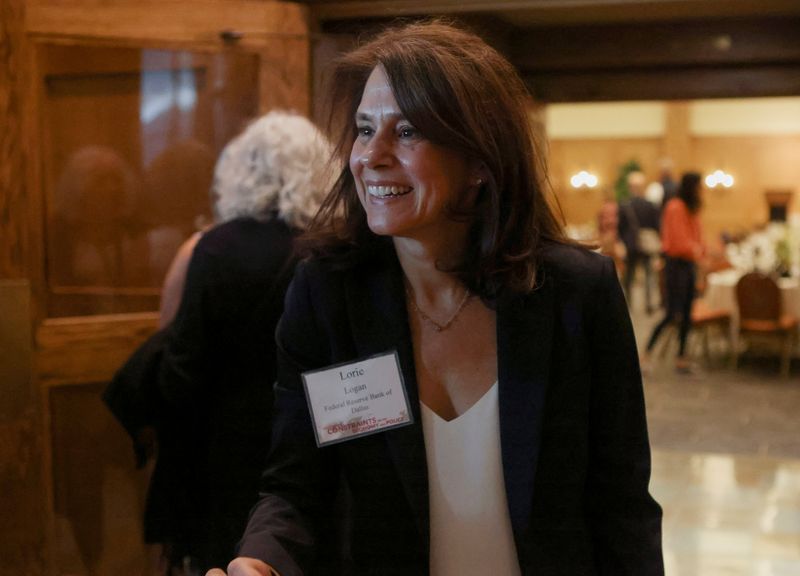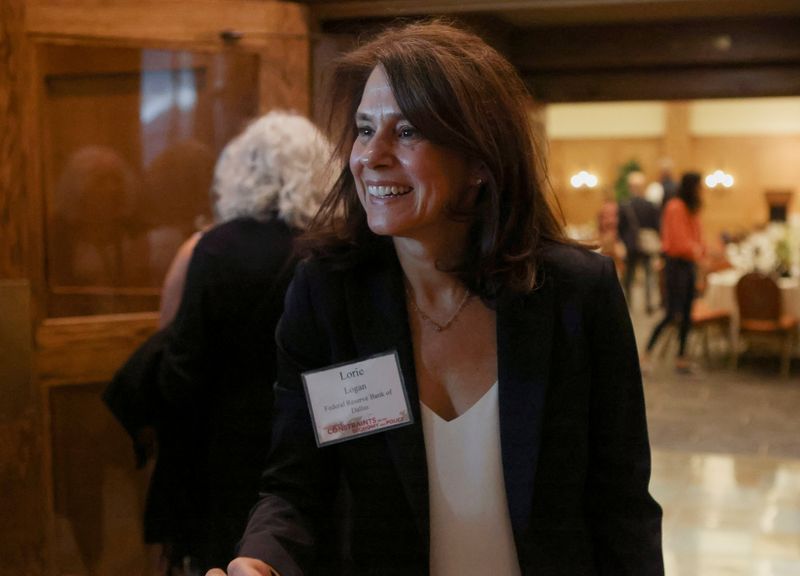Economy
Fed’s Logan says more rate hikes needed amid unexpected economic strength


© Reuters. FILE PHOTO: Lorie Logan, president and CEO of the Federal Reserve Bank of Dallas, attends a dinner program at Grand Teton National Park where financial leaders from around the world are gathering for the Jackson Hole Economic Symposium outside Jackson, Wy
By Michael S. Derby
NEW YORK (Reuters) -Federal Reserve Bank of Dallas President Lorie Logan said Thursday that there was a case for a rate rise at the June policy meeting, in comments that affirmed her view that more rate increases will be needed to cool off a still strong economy.
“It would have been entirely appropriate to raise the federal funds target range at the (Federal Open Market Committee)’s June meeting, consistent with the data we had seen in recent months and the Fed’s dual-mandate goals,” Logan said at an event held at Columbia University. But acknowledging “a challenging and uncertain environment,” Logan said “it can make sense to skip a meeting and move more gradually.”
Logan noted that forecasts released at the June FOMC meeting showed an expectation of more increases, and said “it is important for the FOMC to follow through on the signal we sent in June,” adding “two-thirds of FOMC participants projected at least two more rate increases this year.”
“I remain very concerned about whether inflation will return to target in a sustainable and timely way,” Logan said, adding “the continuing outlook for above-target inflation and a stronger-than-expected labor market calls for more-restrictive monetary policy,” the policymaker said.
Logan is a voting member of the rate-setting Federal Open Market Committee this year.
Logan spoke a day after the release of minutes from the central bank’s June meeting, which offered fresh details on the Fed’s decision to hold rates steady at its policy meeting last month, pausing what had been an aggressive campaign aimed at lowering high levels of inflation.
The meeting minutes showed almost all central bankers favored holding the overnight target rate fixed at between 5% and 5.25% in a bid to see how the cumulative impact of past rate increase were feeding through the economy. Officials were still worried about inflation and flagged a still strong job market, while a minority of policymakers expressed interest in raising rates at the June meeting.
Forecasts from the June FOMC pointed to the possibility of a half percentage point more in rate hikes later this year and Fed officials like central bank Chair Jerome Powell have noted in recent comments the very real prospect that the tightening campaign is not done.
Speaking on Wednesday, New York Fed leader John Williams also said it’s likely the Fed will have to raise rates again but he did not say if he favored a hike at the July FOMC meeting.
In her speech, Logan noted that the economy, as shown by the job market and inflation, was stronger than expected in the first half of the year and added, “while labor market indicators have eased, the overall pace of rebalancing remains slower than previously expected.”
Logan also cast doubt on the idea that there’s some wave of past policy action waiting to flow through the economy, saying “I’m skeptical about the potential for large additional effects from this channel.”
The official also said that she’s watching commercial real estate risks but does not see them as particularly threatening. She said that the broader housing market appears to have bottomed out.
Logan also said that she doesn’t see anything tied to the Fed’s balance sheet drawdown affecting the Fed’s rate choices right now, and said the Treasury’s work to rebuild its cash account is unlikely to hit bank reserves, with the cash instead drawn from the Fed’s reverse repo facility.
Logan said after her formal remarks that she was surprised markets expect a sooner end to the balance sheet drawdown than she bets is likely.
She said it was possible that the Fed could continue to shed bonds it owns even when rates were being cut to adjust to lower inflation, which she said would be a move to maintain monetary policy’s stance relative to the economy’s performance, and not a move to make policy more stimulative.
Economy
Russian central bank says it needs months to make sure CPI falling before rate cuts -RBC


© Reuters. Russian Central Bank Governor Elvira Nabiullina attends a news conference in Moscow, Russia June 14, 2019. REUTERS/Shamil Zhumatov/File Photo
MOSCOW (Reuters) – Russia’s central bank will need two to three months to make sure that inflation is steadily declining before taking any decision on interest rate cuts, the bank’s governor Elvira Nabiullina told RBC media on Sunday.
The central bank raised its key interest rate by 100 basis points to 16% earlier in December, hiking for the fifth consecutive meeting in response to stubborn inflation, and suggested that its tightening cycle was nearly over.
Nabiullina said it was not yet clear when exactly the regulator would start cutting rates, however.
“We really need to make sure that inflation is steadily decreasing, that these are not one-off factors that can affect the rate of price growth in a particular month,” she said.
Nabiullina said the bank was taking into account a wide range of indicators but primarily those that “characterize the stability of inflation”.
“This will take two or three months or more – it depends on how much the wide range of indicators that characterize sustainable inflation declines,” she said.
The bank will next convene to set its benchmark rate on Feb. 16.
The governor also said the bank should have started monetary policy tightening earlier than in July, when it embarked on the rate-hiking cycle.
Economy
China identifies second set of projects in $140 billion spending plan


© Reuters. FILE PHOTO: Workers walk past an under-construction area with completed office towers in the background, in Shenzhen’s Qianhai new district, Guangdong province, China August 25, 2023. REUTERS/David Kirton/File Photo
SHANGHAI (Reuters) – China’s top planning body said on Saturday it had identified a second batch of public investment projects, including flood control and disaster relief programmes, under a bond issuance and investment plan announced in October to boost the economy.
With the latest tranche, China has now earmarked more than 800 billion yuan of its 1 trillion yuan ($140 billion) in additional government bond issuance in the fourth quarter, as it focuses on fiscal steps to shore up the flagging economy.
The National Development and Reform Commission (NDRC) said in a statement on Saturday it had identified 9,600 projects with planned investment of more than 560 billion yuan.
China’s economy, the world’s second largest, is struggling to regain its footing post-COVID-19 as policymakers grapple with tepid consumer demand, weak exports, falling foreign investment and a deepening real estate crisis.
The 1 trillion yuan in additional bond issuance will widen China’s 2023 budget deficit ratio to around 3.8 percent from 3 percent, the state-run Xinhua news agency has said.
“Construction of the projects will improve China’s flood control system, emergency response mechanism and disaster relief capabilities, and better protect people’s lives and property, so it is very significant,” the NDRC said.
The agency said it will coordinate with other government bodies to make sure that funds are allocated speedily for investment and that high standards of quality are maintained in project construction.
($1 = 7.1315 renminbi)
Economy
Russian central bank says it needs months to make sure CPI falling before rate cuts -RBC


© Reuters. Russian Central Bank Governor Elvira Nabiullina attends a news conference in Moscow, Russia June 14, 2019. REUTERS/Shamil Zhumatov/File Photo
MOSCOW (Reuters) – Russia’s central bank will need two to three months to make sure that inflation is steadily declining before taking any decision on interest rate cuts, the bank’s governor Elvira Nabiullina told RBC media on Sunday.
The central bank raised its key interest rate by 100 basis points to 16% earlier in December, hiking for the fifth consecutive meeting in response to stubborn inflation, and suggested that its tightening cycle was nearly over.
Nabiullina said it was not yet clear when exactly the regulator would start cutting rates, however.
“We really need to make sure that inflation is steadily decreasing, that these are not one-off factors that can affect the rate of price growth in a particular month,” she said.
Nabiullina said the bank was taking into account a wide range of indicators but primarily those that “characterize the stability of inflation”.
“This will take two or three months or more – it depends on how much the wide range of indicators that characterize sustainable inflation declines,” she said.
The bank will next convene to set its benchmark rate on Feb. 16.
The governor also said the bank should have started monetary policy tightening earlier than in July, when it embarked on the rate-hiking cycle.

 Forex3 years ago
Forex3 years agoForex Today: the dollar is gaining strength amid gloomy sentiment at the start of the Fed’s week

 Forex3 years ago
Forex3 years agoUnbiased review of Pocket Option broker

 Forex3 years ago
Forex3 years agoDollar to pound sterling exchange rate today: Pound plummeted to its lowest since 1985

 Forex3 years ago
Forex3 years agoHow is the Australian dollar doing today?

 Cryptocurrency3 years ago
Cryptocurrency3 years agoWhat happened in the crypto market – current events today

 World3 years ago
World3 years agoWhy are modern video games an art form?

 Commodities3 years ago
Commodities3 years agoCopper continues to fall in price on expectations of lower demand in China

 Economy3 years ago
Economy3 years agoCrude oil tankers double in price due to EU anti-Russian sanctions





















